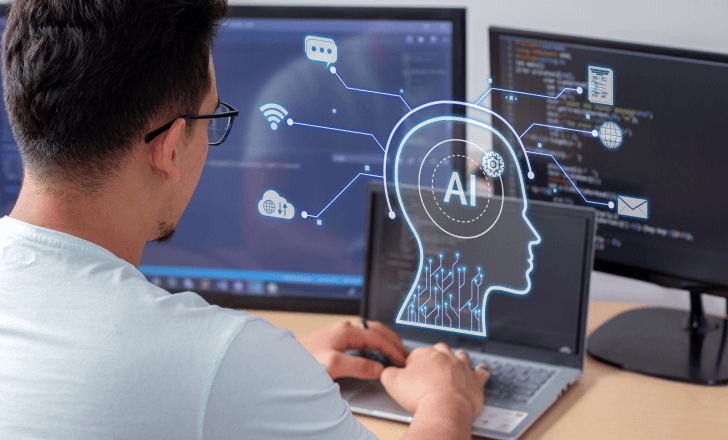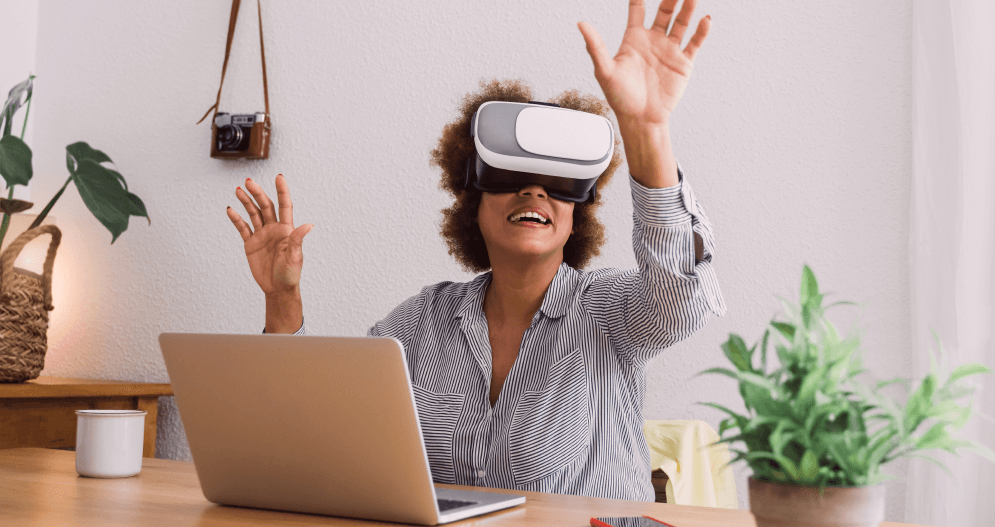As we delve into 2024, the digital design and art world is witnessing a revolutionary shift led by groundbreaking 3D trends.
These trends are not just reshaping the landscape of graphic design and 3D design, but also redefining how we interact with the digital and physical worlds.
This comprehensive guide explores the top five plus one (5+1) 3D trends for 2024, each showcasing the fusion of creativity and technology that is captivating the design world and beyond.
1. 3D collaboration: Revolutionizing teamwork
In 2024, 3D collaboration emerged as a groundbreaking trend, redefining the dynamics of teamwork and creative processes in digital design.
This trend, epitomized by platforms like RealityMAX, represents a significant shift from traditional design methodologies, offering unprecedented interactivity and cooperation among graphic designers, engineers, architects, and other professionals.
The evolution of collaborative platforms
RealityMAX and similar platforms have transformed 3D design by enabling real-time collaboration across global distances.
These platforms facilitate a tech-centric design trend where teams can work simultaneously on the same 3D models, regardless of their physical location.
This level of collaboration was once a logistical challenge, but now it’s a daily reality in many design studios and industries.
Impact on design and development
The impact of this trend extends beyond mere convenience. It’s about enhancing creativity and efficiency. In the digital realm, 3D collaboration allows for immediate feedback and iterative design processes, leading to higher-quality outcomes.
Designers can experiment with abstract shapes, geometric patterns, and complex structures while receiving instant input from colleagues.
This collaborative approach inherently pushes visual experimentation boundaries, fostering a more experimental and expressive method in design projects.
3D collaboration also helps design professional designers streamline their workflows and speed up the once-fragmented review and approval process, which can now happen online and in real-time with clients and stakeholders.
Feedback can be collected instantly and is far more actionable than before, leading to shorter project time and, in the end, improved bottom line.
Transforming industries
The implications of 3D collaborative platforms are vast and varied. In architecture, teams can work together on detailed building models, considering structural, aesthetic, and environmental factors in a holistic manner.
In game design and virtual reality, creators from around the globe can co-develop immersive environments, enhancing the visual storytelling and user experience.
Enhancing learning and creativity
Educational institutions have also embraced 3D collaboration. It’s become a tool for teaching design principles, allowing students to work together on projects in a highly interactive and engaging manner.
This trend is nurturing the next generation of graphic designers and digital artists, equipping them with skills relevant to the ever-evolving tech landscape.
The future of 3D collaboration
3D collaboration is poised to become even more integral in the design world.
As the technology evolves, we can expect these platforms to become more immersive and intuitive, possibly integrating features like AI assistance and advanced analytics.
This will further streamline the design process, making collaboration more seamless and productive.
In conclusion, 3D collaboration represents a major shift in how creative projects are approached and executed in the digital design industry.
Breaking down geographical and logistical barriers has opened up new avenues for creativity, efficiency, and innovation.
This trend is not just a passing graphic design trend; it’s a fundamental change in how the design community works, collaborates, and creates, marking a new era in the digital realm of 3D design.

2. 3D with artificial intelligence: The new frontier
In 2024, the integration of 3D design with artificial intelligence (AI) has emerged as a transformative force in the realm of graphic design and beyond.
This convergence of AI technology and creativity is not just a trend; it’s a paradigm shift, redefining the boundaries of what’s possible in design.
AI’s role in 3D design
AI’s role in 3D design has evolved from a mere tool for assistance to a collaborative partner in the creative process.
AI algorithms can now generate intricate and complex 3D models that seamlessly incorporate abstract geometric shapes and organic forms from natural world.
This capability has given rise to a new graphic design trend that is experimental and expressive, offering designers a novel way to conceptualize and realize their ideas.
Enhancing creativity and efficiency
One of the most significant impacts of AI generated visuals in 3D design is the enhancement of creativity and efficiency.
AI tools can quickly generate multiple design options, perform complex calculations, and suggest improvements, thereby reducing the time and effort involved in the design process.
This efficiency allows designers to focus more on the creative aspects of their projects, pushing the visual experimentation boundaries further.
AI in 3D design has expanded the realm of possibilities for designers. It enables the creation of designs that were previously unimaginable or too complex to model manually.
Designers can experiment with dynamic color palettes, vivid colors, experimental fonts, and unique line styles, blending traditional design and industrial elements, with futuristic concepts.
This trend is particularly evident in digital art, where AI-generated 3D models offer a new level of detail and realism.
Impact across industries
The influence of AI in 3D design extends across various industries.
AI-assisted 3D models enable more accurate and sustainable designs in architecture and urban planning.
In the entertainment industry, particularly in gaming and virtual reality, AI-generated 3D environments provide more immersive and realistic experiences.
Even in sectors like healthcare and manufacturing, AI-driven 3D designs are revolutionizing product development and prototyping.
The future of AI and 3D design
As we look to the future, the integration of AI in 3D design is expected to become more sophisticated.
With advancements in machine learning and computational power, AI will become more adept at understanding and anticipating designer needs, leading to even more collaborative and intuitive design processes.
This progression will further solidify AI’s role as an indispensable tool in the digital design world.
In summary, 3D design with artificial intelligence is a defining trend of the trends for 2024, representing a significant leap forward in how we approach and execute design projects.

3. 3D augmented reality: Blurring lines between worlds
In 2024, 3D Augmented Reality (AR) has taken a front seat in the digital world of the top graphic design trends, digital media, and interactive technology.
This trend is reshaping how we interact with digital content, offering innovative immersive experiences that blend the real with the virtual.
Transforming interaction with digital content
3D AR is revolutionizing the way users interact with digital content. By overlaying 3D designs onto the real world, AR provides a deeply immersive experience that extends beyond the confines of traditional screens.
This technology is being used to create interactive marketing campaigns, educational tools, and entertainment experiences, all of which offer enhanced levels of engagement and interactivity.
Impact on marketing and brand engagement
3D AR is proving to be a game-changer for marketing and brand engagement.
Brands utilize AR to create unique and memorable experiences for their target audience, enabling consumers to interact with products virtually.
For instance, furniture companies use AR to allow customers to visualize how a product would look in their own homes.
This innovative approach to visual storytelling is engaging and offers practical value to consumers.
Enhancing user experience in gaming and VR
The gaming and virtual reality industries are particularly benefiting from the advancements in 3D AR.
Games are becoming more immersive, allowing players to interact with 3D environments in a way that feels more real and tangible.
This trend is pushing the boundaries of gaming, offering experiences that are more engaging, interactive, and visually compelling.
Educational applications
3D AR is also finding significant applications in education, where it’s used to create interactive learning experiences.
From exploring human anatomy in biology classes to visualizing complex geometric shapes in mathematics, AR is enhancing the learning experience, making it more engaging and effective.
Future directions
Looking to the future, 3D AR is set to become even more sophisticated. With the continuous advancements in AR technology, we can expect more realistic and seamless integration of 3D designs into our physical environment.
This evolution will likely lead to new applications in various fields, such as healthcare, where AR could be used for advanced medical training and patient care simulations.
In conclusion, 3D Augmented Reality in 2024 is not just a passing trend but a significant leap forward in how we interact with and perceive digital content. It’s a testament to the power of graphic design and technology in creating immersive experiences that are both engaging and transformative.
As this trend continues to evolve, it promises to open new doors in the realms of marketing anti design, entertainment, education, and beyond, redefining the boundaries of what’s possible in the digital and physical worlds.

4. 3D printing: From concept to reality
In 2024, 3D printing has transcended beyond its initial novelty to become a fundamental aspect of various industries, prominently influencing latest graphic design trends and 3D design landscapes.
This technology has proven its versatility and utility, making the leap from rapid prototyping to full-scale production, packaging design, and artistic expression.
Revolutionizing manufacturing and prototyping
3D printing has dramatically altered the manufacturing sector. Its ability to quickly produce prototypes and complex designs has shortened development cycles and reduced costs.
This trend has allowed for more iterative and experimental approaches to product development, as designers can easily test and refine their 3D designs. The technology’s precision and efficiency make it invaluable in industries ranging from aerospace to consumer electronics.
Artistic expression and customization
In the art and graphic design world, 3D printing has opened up new avenues for creativity minimalist design.
Artists and designers are using this technology to bring their digital creations into the physical world, creating intricate sculptures and installations that were previously impossible to fabricate by traditional means.
This trend has led to a fusion of digital art and traditional craftsmanship, where handcrafted elements, hand drawn art and unique character design styles are brought to life through 3D printing.
Impact on retail and consumer goods
Retail has also embraced 3D printing, particularly in offering customized products.
From personalized accessories to tailor-made furniture, 3D printing allows consumers to have a say in the design of their products, reflecting a shift towards more personalized consumer experiences.
This trend ties in closely with the graphic design trend, where aesthetics and functionality merge to meet specific consumer needs and preferences.
Educational and healthcare advancements
In education, 3D printing is used to enhance learning, particularly in fields like engineering and design, where students can bring their 3D models to life.
In healthcare, it’s paving the way for innovations such as custom prosthetics and bioprinting, where the precision and adaptability of 3D printing are invaluable.
Sustainable practices and future potential
With advancements in eco-friendly materials and processes, sustainability in 3D printing is becoming a significant focus.
This trend aligns with the growing global emphasis on sustainable practices in technology and manufacturing.
The potential of 3D printing in various sectors, including construction and space exploration, is vast. As the technology continues to evolve, its impact on design, production, and innovation will likely grow, solidifying its role in the design industry and beyond.
In 2024, 3D printing stands as a testament to the fusion of technology and creativity. Its applications across different fields underscore its versatility and transformative power, from enhancing artistic self-expression to revolutionizing manufacturing and consumer experiences.
As this technology continues to evolve, it promises to play an even more significant role in shaping the future of design, production, and innovation.

5. 3D designs for stores: Enhancing retail experiences
In 2024, the utilization of 3D designs in retail settings has significantly altered the landscape of e-commerce and brick-and-mortar stores.
This trend marks a pivotal shift in how products are presented and interacted with, offering customers a more immersive and detailed shopping experience.
Enhancing online shopping experience
For online retailers, 3D designs have become crucial in bridging the gap between digital and physical shopping experiences.
Through interactive 3D models and 3D product visualization, customers can explore products in a comprehensive and engaging manner, rotating and zooming in to examine details that static images can’t convey.
This advancement has elevated the standard of online retail, providing a level of interactivity and visualization akin to an in-store experience.
Interactive displays in physical stores
In physical retail spaces, 3D designs are being used to create interactive displays and virtual try-ons.
This trend has given a new dimension to traditional retail by allowing customers to visualize products in different scenarios or customize them according to their preferences.
For instance, furniture stores use 3D models to show how different pieces would look in various room settings, while clothing retailers offer virtual fitting rooms where customers can try on clothes digitally.
Impact on customer engagement and sales
The integration of 3D designs in retail has shown a positive impact on customer engagement and sales.
By providing a more interactive and informative shopping experience, retailers have seen increased customer satisfaction and decreased return rates.
The ability to visualize products in detail helps customers make more informed decisions, leading to a more confident purchase.
Role in marketing and branding
3D designs in retail have also transformed marketing strategies.
Brands can now showcase their products innovatively, creating stunning visuals and visual storytelling that captures the attention of their target audience.
This approach has proven effective in building brand identity and driving customer interest, especially when combined with other graphic design elements like bold fonts, vibrant colors, and unique line styles.
Future outlook
Looking ahead, 3D designs in retail are expected to become more prevalent and sophisticated.
With advancements in AR and VR technologies, the line between physical and digital shopping experiences will continue to blur, offering even more immersive and personalized shopping experiences.
This trend is redefining retail and shaping the future of consumer behavior and the design industry as a whole.
In summary, the incorporation of 3D designs in retail settings in 2024 represents a significant shift in how products are presented and experienced.
This trend is enhancing both online and offline shopping experiences, offering customers a new level of interaction and visualization.
As technology continues to evolve, 3D designs in retail will undoubtedly play a pivotal role in shaping the future of shopping, marketing, and customer engagement.

(+1). Mixing 2D and 3D images: A creative fusion
The innovative trend of mixing 2D and 3D images in 2024 has become a hallmark of popular trends in the world of graphic design, representing a creative synthesis that blurs the lines between flat art and volumetric realism.
This design trend is not just about juxtaposing two different styles of character design; it’s about creating a cohesive visual narrative that leverages the strengths of both dimensions.
Artistic fusion and visual appeal
Combining 2D and 3D elements in a single composition offers a unique aesthetic that is eye-catching and thought-provoking.
This approach allows for a playful interplay between the flat, often minimalist nature of 2D graphics and the depth and realism of 3D imagery.
Graphic designers are using this technique to mine color palette to create compositions that are visually dynamic and rich in color palette texture, offering viewers a multi-layered visual experience.
Enhancing storytelling and communication
This trend goes beyond mere aesthetics; it’s a powerful tool for storytelling and communication.
By mixing 2D and 3D elements, designers can guide the viewer’s eye through the composition of packaging design, highlighting key messages or creating a narrative flow.
This method of design is particularly effective in digital advertising, social media graphics, and visual storytelling, where the goal is to convey complex ideas or emotions in an engaging and accessible way.
Applications in branding and marketing
This graphic design trend has found significant application in branding and marketing.
Brands are utilizing the 2D-3D fusion to create distinctive and memorable visual identities. This same design style allows for a versatile fusion style color combinations of traditional and modern design elements, making it possible to appeal to a broad audience while still maintaining a unique and modern aesthetic.
Impact on user interface and web design
The mixing of 2D and 3D elements is also making waves in the field of user interface (UI) and web design.
Many designers are leveraging this trend to create more intuitive and visually engaging interfaces. By incorporating 3D elements into a predominantly 2D layout, UI designers can now create designs with a sense of depth and hierarchy, improving the overall user experience.
Future perspectives
The fusion of 2D and 3D imagery will likely evolve with software and rendering technology advancements as we look to the future.
This evolution will enable even more seamless and creative integrations of these two styles, pushing the boundaries of what is possible in graphic design and visual communication.
In conclusion, the trend of mixing 2D and 3D images in 2024 represents a significant development in the graphic design industry. It’s a testament to the creative potential that emerges when different styles and dimensions are brought together.
This trend is not just a passing phase charming graphic design trend; it’s a reflection of the ongoing evolution and experimentation in the digital design world, offering new opportunities for expression, communication, and engagement in the ever-evolving tech landscape.

Conclusion: Charting the future of design with 2024’s pioneering 3D trends
The 5+1 3D trends have catalyzed a transformative era in graphic design and digital art, merging technology with creativity in unprecedented ways. These trends mark a significant evolution in the design world, showcasing its versatility and capacity for innovation.
From the collaborative ingenuity of platforms like RealityMAX to the immersive experiences of 3D augmented reality and the practical applications of 3D printing, each trend is redefining the boundaries of design. They highlight a future where the design industry continues to thrive, driven by a relentless pursuit of innovation and a fusion of digital and physical elements.
In essence, these newest graphic design trends are not just shaping the present; they are paving the way for a future where graphic design transcends traditional limits, embracing new technologies and creative possibilities in an ever-evolving landscape.
